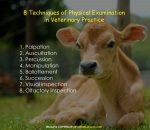Calf pneumonia is the second major health problem of dairy and beef calves, after calf diarrhea. Pneumonia is the term that means inflammation of the lungs. Pneumonia can be subclinical to acute, chronic, & fatal.
Calf Pneumonia Pathogens
Major organisms that are involved in this disease are following
- Pasteurella multocida
- Pasteurella hemolytica
- Corynebacterium pyogenes
- Neisseria spp
- Chlamydia spp
- Haemophilus somnus
- Parainfluenza 3 Virus
Calf Pneumonia Symptoms
Clinical signs that are observed in diseased calves are following
- Nasal Discharge
- Dry Coughing
- High Rectal Temperature (41 Degree Celsius)
- Respiratory distress exhibiting difficult breathing
- Calves will be dull & depressed
Calf Pneumonia Treatment
- Early disease detection is important to increase the survival chance of the calf.
- Place the calf in a dry, warm, less humid & well-ventilated environment.
- Antibiotics should be used to reduce the effect of secondary bacterial invasion.
- Anti-inflammatory and antipyretic drugs can be used to provide relief to the animal.
Prevention
By eliminating the predisposing factors or reducing the faulty management practices, the incidence of calf pneumonia can be reduced. Following measures can help to reduce the risk of pneumonia
- Offer an adequate amount of colostrum
- Avoid nutritional stress for calves
- Provide good natural ventilation
- Ensure dry and proper housing
- Ensure a proper vaccination schedule along with effective management to reduce the risk of infection.
- Make sure proper care of newborn calf in order to maintain its good health and immunity
Calves must be offered colostrum 1/10th of their body weight within the first 24 hours after calving. Calves that are not provided an adequate amount of antibodies (passive immunity) are at increased risk of developing scour and pneumonia.


